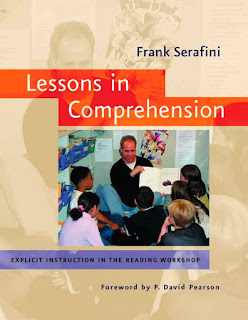The Best of Frank Serafini - Thoughts on Lessons in Comprehension
There is no single method of reading. T.S. Eliot once said that there was no method except to be very intelligent. I should prefer to say that, for most of us with middling gifts in the way of pure intelligence, serious attention to the craft of reading can take us quite far. Reading is the route to intelligence, not the goal of it. It is proper attention to the craft of reading that will make the reader crafty.
Robert Scholes, The Crafty Reader
It seems that everyone is concerned with the nature of the reading instructional experiences we offer our students, the scientific foundations upon which we base these experiences, how these instructional experiences will help readers develop their literate abilities and how we plan to measure achievement and growth in reading proficiency. Given the pressures of adopting particular commercial reading programs by federal and state legislation, it has become apparent that we, as classroom teachers, need to be able to articulate the role direct or explicit comprehension instruction plays in our reading instructional framework. Does this mean that teachers have to follow the scope and sequence of a commercial reading program in order to ensure effective instruction? I don’t believe so.Although the search for the perfect reading program is “fraught with pitfalls,” it is important to analyze the criteria we use to distinguish exemplary reading instruction from poorly constructed reading instruction. Over the past three decades, there has been a shift back and forth from scripted, teacher-centered reading instruction lessons taken from commercial programs, to student-centered, comprehension lessons designed by classroom teachers and conducted within a reading workshop approach. Because of these shifts, the criteria used to evaluate what constitutes a quality lesson has to change to align with new perspectives on reading instruction. The question remains, “How do we know a quality comprehension lesson when we see one?”
Reading instruction and literacy development isn’t as neat and orderly as some commercial reading programs would like to portray. Effective classroom teachers know this. Parents of struggling readers know this. And, probably struggling readers themselves know this. Ask any effective teacher if teaching readers to make sense of what they are reading is as easy as following a set of scripted lessons and you will hear a resounding, “No!” Teachers that teach reading know that effective comprehension instruction is a complicated process that involves a vast array of instructional components, procedures and considerations.
Young people become better readers by reading. No matter what cognitive capacities they bring to the reading event, practicing reading makes them better readers. I believe that students rise to our expectations. If we see them as readers and treat them as readers, they will come to see themselves as readers, and from then on there is no stopping them.
In a society that desires fast food over quality nutrition, it should come as no surprise that we skim along the top of the reading curriculum. District, state and federal curriculum guidelines mandate additional requirements to an already overburdened reading curriculum. As teachers, we are told we need to teach faster and harder every day if we expect to see results. How unfortunate, and absurd. The expansion of the reading curriculum forces teachers to sacrifice depth of understanding for coverage of specific topics. Our reading curriculua have become a “trivial pursuit” for trivial knowledge.
It may seem counter-intuitive for me to be calling for teachers to slow down and revisit books again and again throughout the year. Several of the comprehension lessons included in this text, require teachers to return to favorite and familiar titles to allow students to develop new interpretations, comprehension practices, and deeper understandings. I hope teachers see the value in this proposal. If we keep forcing readers to read only books they haven’t seen before, instead of allowing them to revisit favorites from time to time, we are denying them access to the multiple layers of meaning that can be generated during additional transactions with quality literature.
Novice readers come to understand what reading IS as they come to understand HOW to read. Reading is a life long process of making sense of the world and our place in it. It is not a rush to finish books, nor to accumulate reading “trophies” by answering five questions on some computer quiz. Our teaching must convey this message as much as it helps readers learn to read. If we don’t help readers understand whythey should read, they won’t care about learning how to do it.


Comments
Post a Comment